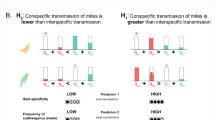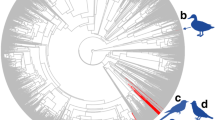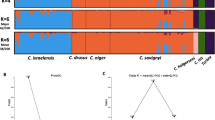Abstract
A growing body of empirical and theoretical work supports the plausibility of sympatric speciation1,2,3, but there remain few examples in which all the essential components of the process are well understood. The African indigobirds Vidua spp. are host-specific brood parasites. Indigobird nestlings are reared along with host young, and mimic the mouth markings of their respective hosts4,5,6. As adults, male indigobirds mimic host song4,5,6,7, whereas females use these songs to choose both their mates and the nests they parasitize8. These behavioural mechanisms promote the cohesion of indigobird populations associated with a given host species, and provide a mechanism for reproductive isolation after a new host is colonized. Here we show that all indigobird species are similar genetically, but are significantly differentiated in both mitochondrial haplotype and nuclear allele frequencies. These data support a model of recent sympatric speciation. In contrast to the cuckoo Cuculus canorus, in which only female lineages are faithful to specific hosts9,10, host switches have led to speciation in indigobirds because both males and females imprint on their hosts8,11.
This is a preview of subscription content, access via your institution
Access options
Subscribe to this journal
Receive 51 print issues and online access
$199.00 per year
only $3.90 per issue
Buy this article
- Purchase on Springer Link
- Instant access to full article PDF
Prices may be subject to local taxes which are calculated during checkout



Similar content being viewed by others
References
Via, S. Sympatric speciation in animals: the ugly duckling grows up. Trends Ecol. Evol. 16, 381–390 (2001)
Berlocher, S. H. & Feder, J. L. Sympatric speciation in phytophagous insects: moving beyond controversy? Annu. Rev. Entomol. 47, 773–815 (2002)
Dieckmann, U. & Doebeli, M. On the origin of species by sympatric speciation. Nature 400, 354–357 (1999)
Nicolai, J. Der Brutparasitismus der Viduinae als ethologisches Problem. Z. Tierpsychol. 21, 129–204 (1964)
Payne, R. B. Behavior, mimetic songs and song dialects, and relationships of the parasitic indigobirds (Vidua) of Africa. Ornithol. Monogr. 11, 1–333 (1973)
Payne, R. B. Species limits in the indigobirds (Ploceidae, Vidua) of West Africa: mouth mimicry, song mimicry, and description of new species. Misc. Publ. Univ. Mich. Mus. Zool. 162, 1–96 (1982)
Payne, R. B. & Payne, L. L. Song mimicry and species associations of West African indigobirds Vidua with quail-finch Ortygospiza atricollis, goldbreast Amandava subflava and brown twinspot Clytospiza monteiri.. Ibis (Lond. 1859) 136, 291–304 (1994)
Payne, R. B., Payne, L. L., Woods, J. L. & Sorenson, M. D. Imprinting and the origin of parasite-host species associations in brood–parasitic indigobirds, Vidua chalybeata. Anim. Behav. 59, 69–81 (2000)
Gibbs, H. L. et al. Genetic evidence for female host-specific races of the common cuckoo. Nature 407, 183–186 (2000)
Marchetti, K., Nakamura, H. & Gibbs, H. L. Host-race formation in the common cuckoo. Science 282, 471–472 (1998)
Payne, R. B., Payne, L. L. & Woods, J. L. Song learning in brood-parasitic indigobirds Vidua chalybeata: song mimicry of the host species. Anim. Behav. 55, 1537–1553 (1998)
Klein, N. K. & Payne, R. B. Evolutionary associations of brood parasitic finches (Vidua) and their host species: Analyses of mitochondrial DNA restriction sites. Evolution 52, 566–582 (1998)
Sorenson, M. D. & Payne, R. B. Molecular genetic perspectives on avian brood parasitism. Integr. Comp. Biol. 42, 388–400 (2002)
Payne, R. B., Payne, L. L., Nhlane, M. E. D. & Hustler, K. Species status and distribution of the parasitic indigo-birds Vidua in east and southern Africa. Proc. VIII Pan-Afr. Ornithol. Congr., 40–52 (Bujumbura, Burundi, 1993)
Avise, J. C. Phylogeography: The History and Formation of Species (Harvard Univ. Press, Cambridge, Massachusetts, 2000)
Payne, R. B., Hustler, K., Stjernstedt, R., Sefc, K. M. & Sorenson, M. D. Behavioural and genetic evidence of a recent population switch to a novel host species in brood-parasitic indigobirds Vidua chalybeata. Ibis (Lond. 1859) 144, 373–383 (2002)
Slatkin, M. Gene flow and the geographic structure of natural populations. Science 236, 787–792 (1987)
Balloux, F. & Lugon-Moulin, N. The estimation of population differentiation with microsatellite markers. Mol. Ecol. 11, 155–165 (2002)
Hedrick, P. W. Perspective: highly variable loci and their interpretation in evolution and conservation. Evolution 53, 313–318 (1999)
Sorenson, M. D. & Payne, R. B. A single ancient origin of brood parasitism in African finches: implications for host–parasite coevolution. Evolution 55, 2550–2567 (2001)
Edwards, S. V. & Beerli, P. Perspective: gene divergence, population divergence, and the variance in coalescence time in phylogeographic studies. Evolution 54, 1839–1854 (2000)
Lotem, A., Nakamura, H. & Zahavi, A. Constraints on egg discrimination and cuckoo host coevolution. Anim. Behav. 49, 1185–1209 (1995)
Payne, R. B., Woods, J. L. & Payne, L. L. Parental care in estrildid finches: experimental tests of a model of Vidua brood parasitism. Anim. Behav. 62, 473–483 (2001)
de Queiroz, K. in Endless Forms: Species and Speciation (eds Howard, D. & Berlocher, S. H.) 57–75 (Oxford Univ. Press, Oxford, 1998)
Sefc, K. M., Payne, R. B. & Sorenson, M. D. Characterization of microsatellite loci in village indigobirds Vidua chalybeata and cross-species amplification in estrildid and ploceid finches. Mol. Ecol. Notes 1, 252–254 (2001)
Swofford, D. L. PAUP*. Phylogenetic Analysis Using Parsimony (*and Other Methods), Version 4.0b10 (Sinauer Associates, Sunderland, Massachusetts, 2002)
Schneider, S. D., Roesslo, D. & Excoffier, L. ARLEQUIN: A Software for Population Genetics Analysis (Univ. Geneva, Switzerland, 2000)
Goodman, S. J. RST Calc: a collection of computer programs for calculating estimates of genetic differentiation from microsatellite data and determining their significance. Mol. Ecol. 6, 881–885 (1997)
Sanderson, M. J. r8s, Version 1.60 (Univ. California Davis, California, 2003)
Payne, R. B. Field identification of the indigobirds. Bull. Afr. Bird Club 3, 14–25 (1996)
Acknowledgements
For comments, logistical support, and assistance in the field and lab, we thank Laura Payne, Chris Balakrishnan, Clive Barlow, Adrian Craig, Nick Davies, Roger Fotso, Kathy Groschupf, Janet Hinshaw, Mark Hopkins, Kit Hustler, Lacey Knowles, Kevin Njabo, Nedra Klein, David Mindell, and Bob Stjernstedt. Funding was provided by US National Science Foundation Grants to R.B.P. and M.D.S. and an Erwin Schrödinger Fellowship from the Austrian Science Fund for K.M.S.
Author information
Authors and Affiliations
Corresponding author
Ethics declarations
Competing interests
The authors declare that they have no competing financial interests.
Supplementary information
Rights and permissions
About this article
Cite this article
Sorenson, M., Sefc, K. & Payne, R. Speciation by host switch in brood parasitic indigobirds. Nature 424, 928–931 (2003). https://doi.org/10.1038/nature01863
Received:
Accepted:
Issue Date:
DOI: https://doi.org/10.1038/nature01863
This article is cited by
-
Ecological disruptive selection acting on quantitative loci can drive sympatric speciation
npj Systems Biology and Applications (2024)
-
Resource trait specialisation in an introduced fish population with reduced genetic diversity
Biological Invasions (2020)
-
The reach of gene–culture coevolution in animals
Nature Communications (2019)
-
Mitogenome types of two Lentinula edodes sensu lato populations in China
Scientific Reports (2019)
-
Do cuckoos imprint on hosts, micro-habitats, or nest sites? Parasitism preferences in the common cuckoo (Cuculus canorus)
Behavioral Ecology and Sociobiology (2018)
Comments
By submitting a comment you agree to abide by our Terms and Community Guidelines. If you find something abusive or that does not comply with our terms or guidelines please flag it as inappropriate.



